Palliative Care Nursing: Caregiver's Role and 5Rs Framework Analysis
VerifiedAdded on 2022/10/17
|7
|1432
|11
Report
AI Summary
This report delves into the complexities of palliative care nursing, emphasizing the pivotal role of family caregivers in supporting patients transitioning from hospital to home. It highlights the significance of the 5Rs reflection framework (Reporting, Responding, Relating, Reasoning, Restructuring) in enhancing caregivers' knowledge and skills. The report addresses the stressors and challenges faced by caregivers, including emotional strain and the need for effective communication. It also explores the application of the adaptation model in providing care and the importance of self-help strategies for caregivers. The analysis underscores the need for comprehensive support systems, including communication strategies and self-help groups, to alleviate caregiver burden and improve patient outcomes. The report references NMBA standards, nursing ethics, and relevant research to provide a thorough understanding of palliative care nursing practices.
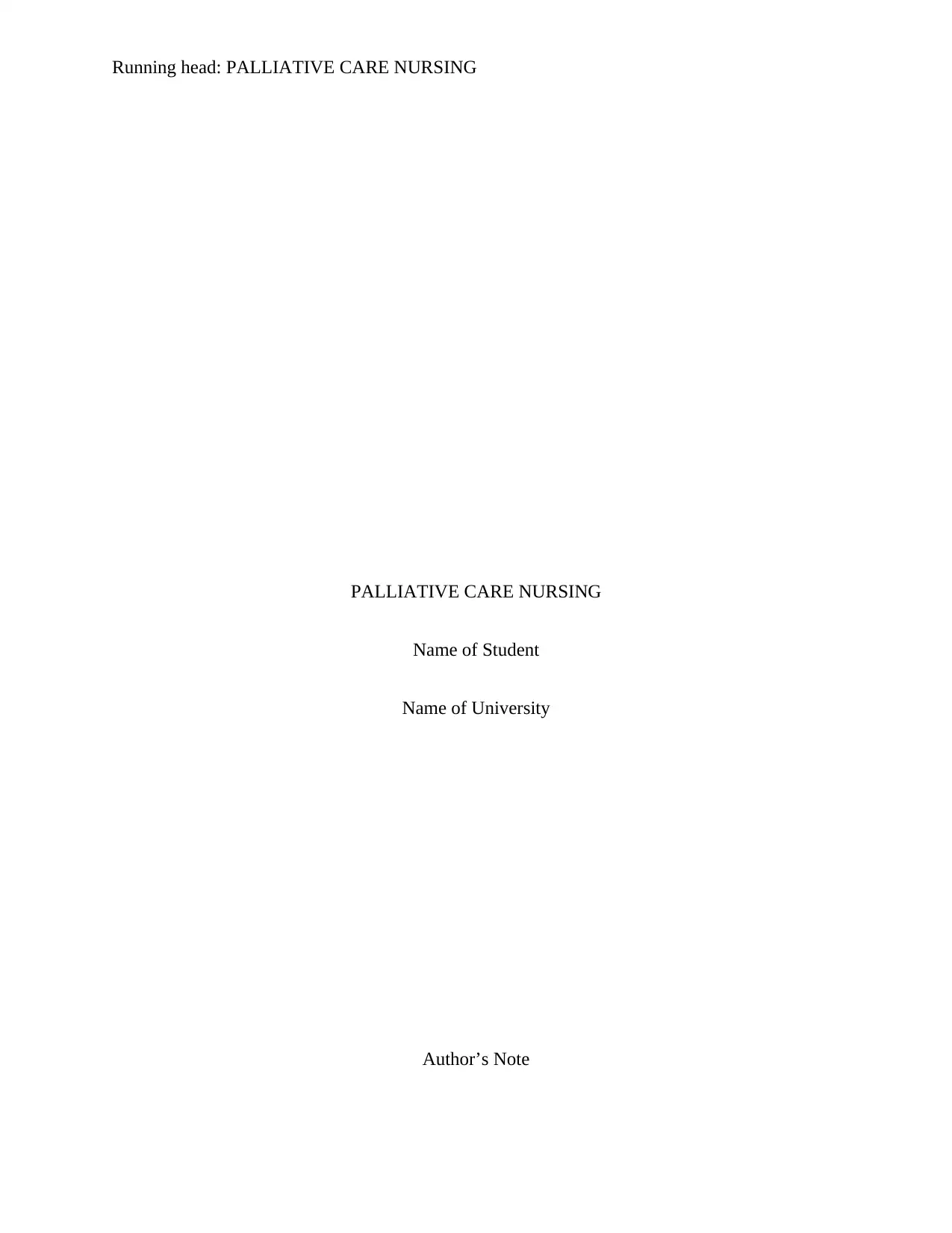
Running head: PALLIATIVE CARE NURSING
PALLIATIVE CARE NURSING
Name of Student
Name of University
Author’s Note
PALLIATIVE CARE NURSING
Name of Student
Name of University
Author’s Note
Paraphrase This Document
Need a fresh take? Get an instant paraphrase of this document with our AI Paraphraser
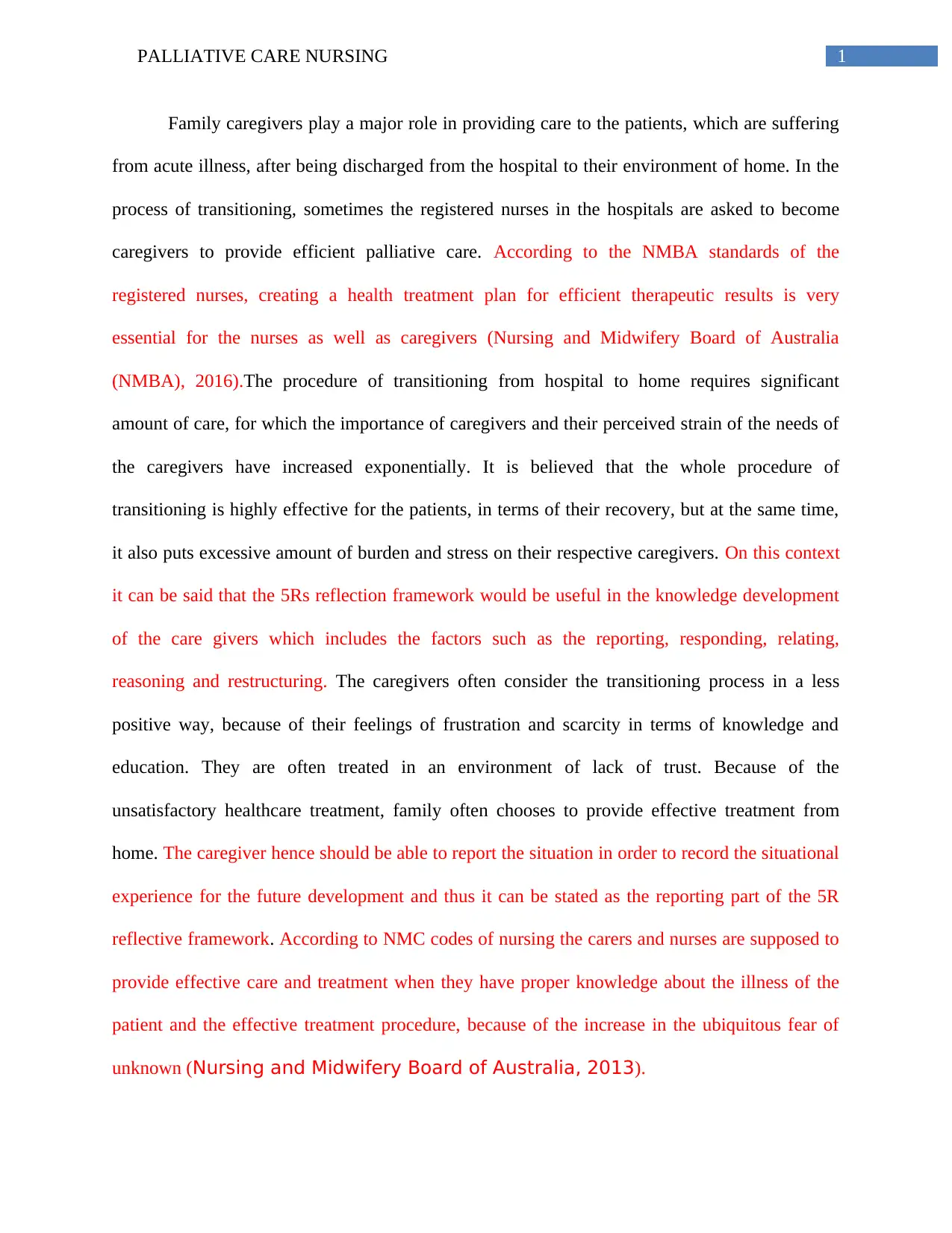
1PALLIATIVE CARE NURSING
Family caregivers play a major role in providing care to the patients, which are suffering
from acute illness, after being discharged from the hospital to their environment of home. In the
process of transitioning, sometimes the registered nurses in the hospitals are asked to become
caregivers to provide efficient palliative care. According to the NMBA standards of the
registered nurses, creating a health treatment plan for efficient therapeutic results is very
essential for the nurses as well as caregivers (Nursing and Midwifery Board of Australia
(NMBA), 2016).The procedure of transitioning from hospital to home requires significant
amount of care, for which the importance of caregivers and their perceived strain of the needs of
the caregivers have increased exponentially. It is believed that the whole procedure of
transitioning is highly effective for the patients, in terms of their recovery, but at the same time,
it also puts excessive amount of burden and stress on their respective caregivers. On this context
it can be said that the 5Rs reflection framework would be useful in the knowledge development
of the care givers which includes the factors such as the reporting, responding, relating,
reasoning and restructuring. The caregivers often consider the transitioning process in a less
positive way, because of their feelings of frustration and scarcity in terms of knowledge and
education. They are often treated in an environment of lack of trust. Because of the
unsatisfactory healthcare treatment, family often chooses to provide effective treatment from
home. The caregiver hence should be able to report the situation in order to record the situational
experience for the future development and thus it can be stated as the reporting part of the 5R
reflective framework. According to NMC codes of nursing the carers and nurses are supposed to
provide effective care and treatment when they have proper knowledge about the illness of the
patient and the effective treatment procedure, because of the increase in the ubiquitous fear of
unknown (Nursing and Midwifery Board of Australia, 2013).
Family caregivers play a major role in providing care to the patients, which are suffering
from acute illness, after being discharged from the hospital to their environment of home. In the
process of transitioning, sometimes the registered nurses in the hospitals are asked to become
caregivers to provide efficient palliative care. According to the NMBA standards of the
registered nurses, creating a health treatment plan for efficient therapeutic results is very
essential for the nurses as well as caregivers (Nursing and Midwifery Board of Australia
(NMBA), 2016).The procedure of transitioning from hospital to home requires significant
amount of care, for which the importance of caregivers and their perceived strain of the needs of
the caregivers have increased exponentially. It is believed that the whole procedure of
transitioning is highly effective for the patients, in terms of their recovery, but at the same time,
it also puts excessive amount of burden and stress on their respective caregivers. On this context
it can be said that the 5Rs reflection framework would be useful in the knowledge development
of the care givers which includes the factors such as the reporting, responding, relating,
reasoning and restructuring. The caregivers often consider the transitioning process in a less
positive way, because of their feelings of frustration and scarcity in terms of knowledge and
education. They are often treated in an environment of lack of trust. Because of the
unsatisfactory healthcare treatment, family often chooses to provide effective treatment from
home. The caregiver hence should be able to report the situation in order to record the situational
experience for the future development and thus it can be stated as the reporting part of the 5R
reflective framework. According to NMC codes of nursing the carers and nurses are supposed to
provide effective care and treatment when they have proper knowledge about the illness of the
patient and the effective treatment procedure, because of the increase in the ubiquitous fear of
unknown (Nursing and Midwifery Board of Australia, 2013).
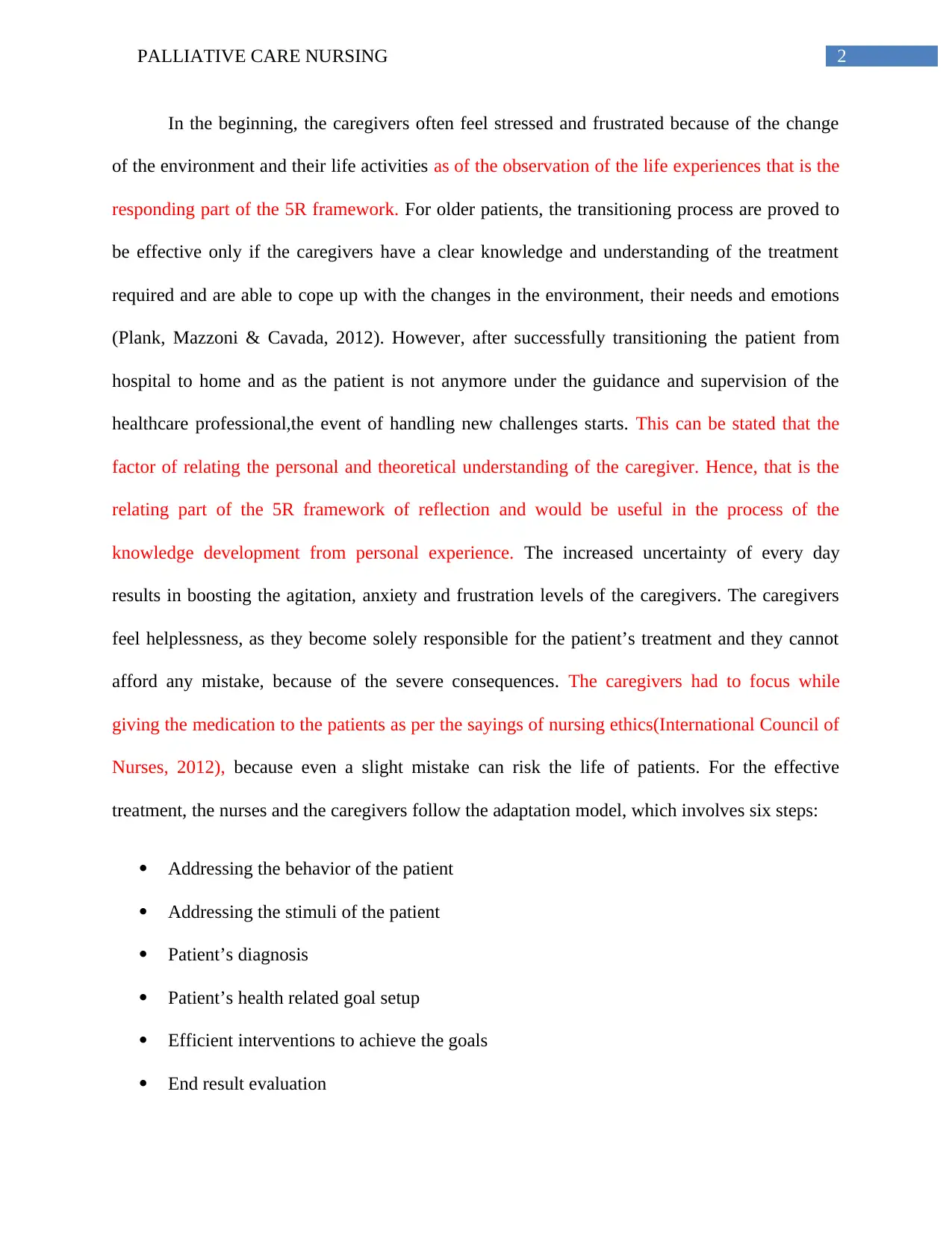
2PALLIATIVE CARE NURSING
In the beginning, the caregivers often feel stressed and frustrated because of the change
of the environment and their life activities as of the observation of the life experiences that is the
responding part of the 5R framework. For older patients, the transitioning process are proved to
be effective only if the caregivers have a clear knowledge and understanding of the treatment
required and are able to cope up with the changes in the environment, their needs and emotions
(Plank, Mazzoni & Cavada, 2012). However, after successfully transitioning the patient from
hospital to home and as the patient is not anymore under the guidance and supervision of the
healthcare professional,the event of handling new challenges starts. This can be stated that the
factor of relating the personal and theoretical understanding of the caregiver. Hence, that is the
relating part of the 5R framework of reflection and would be useful in the process of the
knowledge development from personal experience. The increased uncertainty of every day
results in boosting the agitation, anxiety and frustration levels of the caregivers. The caregivers
feel helplessness, as they become solely responsible for the patient’s treatment and they cannot
afford any mistake, because of the severe consequences. The caregivers had to focus while
giving the medication to the patients as per the sayings of nursing ethics(International Council of
Nurses, 2012), because even a slight mistake can risk the life of patients. For the effective
treatment, the nurses and the caregivers follow the adaptation model, which involves six steps:
Addressing the behavior of the patient
Addressing the stimuli of the patient
Patient’s diagnosis
Patient’s health related goal setup
Efficient interventions to achieve the goals
End result evaluation
In the beginning, the caregivers often feel stressed and frustrated because of the change
of the environment and their life activities as of the observation of the life experiences that is the
responding part of the 5R framework. For older patients, the transitioning process are proved to
be effective only if the caregivers have a clear knowledge and understanding of the treatment
required and are able to cope up with the changes in the environment, their needs and emotions
(Plank, Mazzoni & Cavada, 2012). However, after successfully transitioning the patient from
hospital to home and as the patient is not anymore under the guidance and supervision of the
healthcare professional,the event of handling new challenges starts. This can be stated that the
factor of relating the personal and theoretical understanding of the caregiver. Hence, that is the
relating part of the 5R framework of reflection and would be useful in the process of the
knowledge development from personal experience. The increased uncertainty of every day
results in boosting the agitation, anxiety and frustration levels of the caregivers. The caregivers
feel helplessness, as they become solely responsible for the patient’s treatment and they cannot
afford any mistake, because of the severe consequences. The caregivers had to focus while
giving the medication to the patients as per the sayings of nursing ethics(International Council of
Nurses, 2012), because even a slight mistake can risk the life of patients. For the effective
treatment, the nurses and the caregivers follow the adaptation model, which involves six steps:
Addressing the behavior of the patient
Addressing the stimuli of the patient
Patient’s diagnosis
Patient’s health related goal setup
Efficient interventions to achieve the goals
End result evaluation
⊘ This is a preview!⊘
Do you want full access?
Subscribe today to unlock all pages.

Trusted by 1+ million students worldwide
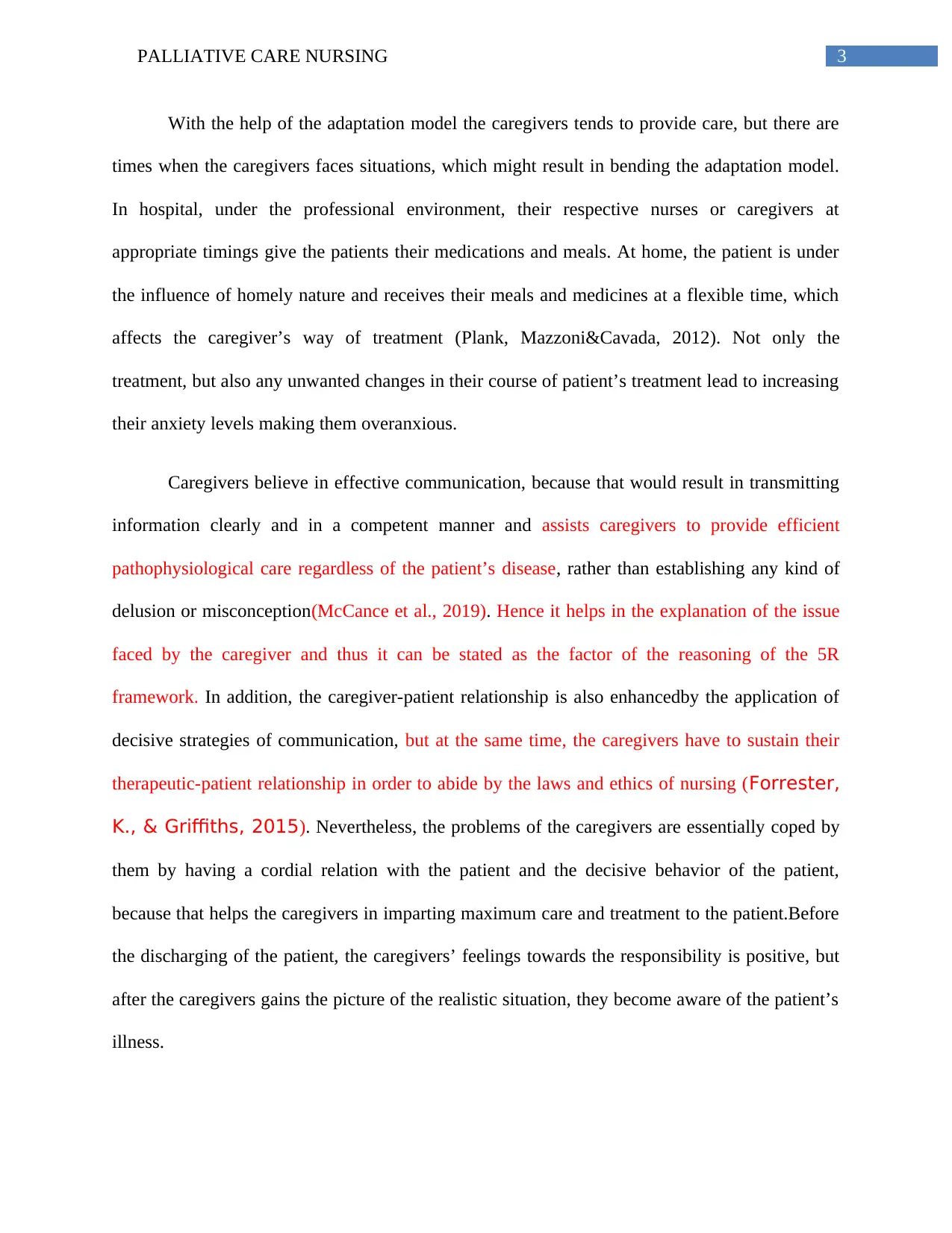
3PALLIATIVE CARE NURSING
With the help of the adaptation model the caregivers tends to provide care, but there are
times when the caregivers faces situations, which might result in bending the adaptation model.
In hospital, under the professional environment, their respective nurses or caregivers at
appropriate timings give the patients their medications and meals. At home, the patient is under
the influence of homely nature and receives their meals and medicines at a flexible time, which
affects the caregiver’s way of treatment (Plank, Mazzoni&Cavada, 2012). Not only the
treatment, but also any unwanted changes in their course of patient’s treatment lead to increasing
their anxiety levels making them overanxious.
Caregivers believe in effective communication, because that would result in transmitting
information clearly and in a competent manner and assists caregivers to provide efficient
pathophysiological care regardless of the patient’s disease, rather than establishing any kind of
delusion or misconception(McCance et al., 2019). Hence it helps in the explanation of the issue
faced by the caregiver and thus it can be stated as the factor of the reasoning of the 5R
framework. In addition, the caregiver-patient relationship is also enhancedby the application of
decisive strategies of communication, but at the same time, the caregivers have to sustain their
therapeutic-patient relationship in order to abide by the laws and ethics of nursing (Forrester,
K., & Griffiths, 2015). Nevertheless, the problems of the caregivers are essentially coped by
them by having a cordial relation with the patient and the decisive behavior of the patient,
because that helps the caregivers in imparting maximum care and treatment to the patient.Before
the discharging of the patient, the caregivers’ feelings towards the responsibility is positive, but
after the caregivers gains the picture of the realistic situation, they become aware of the patient’s
illness.
With the help of the adaptation model the caregivers tends to provide care, but there are
times when the caregivers faces situations, which might result in bending the adaptation model.
In hospital, under the professional environment, their respective nurses or caregivers at
appropriate timings give the patients their medications and meals. At home, the patient is under
the influence of homely nature and receives their meals and medicines at a flexible time, which
affects the caregiver’s way of treatment (Plank, Mazzoni&Cavada, 2012). Not only the
treatment, but also any unwanted changes in their course of patient’s treatment lead to increasing
their anxiety levels making them overanxious.
Caregivers believe in effective communication, because that would result in transmitting
information clearly and in a competent manner and assists caregivers to provide efficient
pathophysiological care regardless of the patient’s disease, rather than establishing any kind of
delusion or misconception(McCance et al., 2019). Hence it helps in the explanation of the issue
faced by the caregiver and thus it can be stated as the factor of the reasoning of the 5R
framework. In addition, the caregiver-patient relationship is also enhancedby the application of
decisive strategies of communication, but at the same time, the caregivers have to sustain their
therapeutic-patient relationship in order to abide by the laws and ethics of nursing (Forrester,
K., & Griffiths, 2015). Nevertheless, the problems of the caregivers are essentially coped by
them by having a cordial relation with the patient and the decisive behavior of the patient,
because that helps the caregivers in imparting maximum care and treatment to the patient.Before
the discharging of the patient, the caregivers’ feelings towards the responsibility is positive, but
after the caregivers gains the picture of the realistic situation, they become aware of the patient’s
illness.
Paraphrase This Document
Need a fresh take? Get an instant paraphrase of this document with our AI Paraphraser
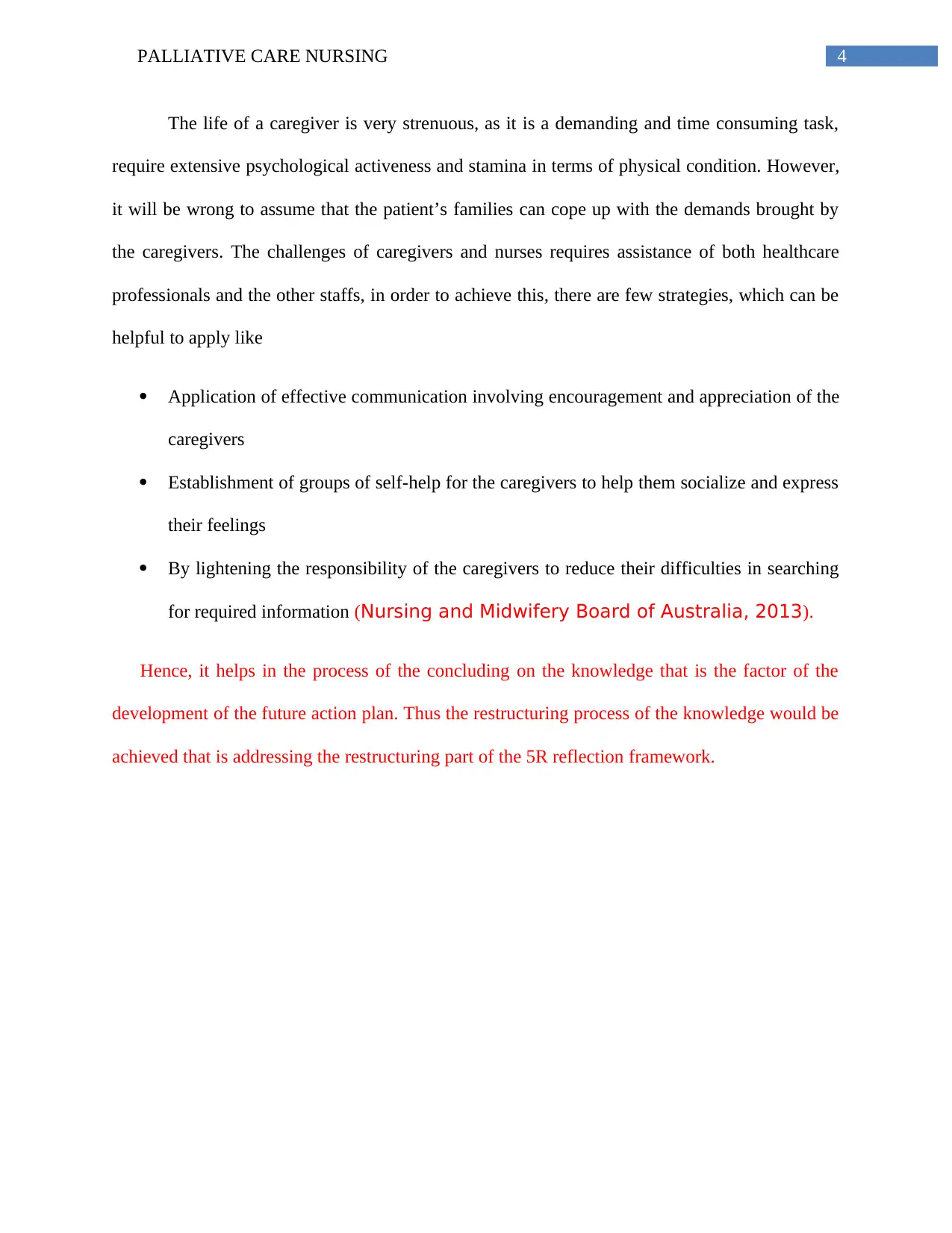
4PALLIATIVE CARE NURSING
The life of a caregiver is very strenuous, as it is a demanding and time consuming task,
require extensive psychological activeness and stamina in terms of physical condition. However,
it will be wrong to assume that the patient’s families can cope up with the demands brought by
the caregivers. The challenges of caregivers and nurses requires assistance of both healthcare
professionals and the other staffs, in order to achieve this, there are few strategies, which can be
helpful to apply like
Application of effective communication involving encouragement and appreciation of the
caregivers
Establishment of groups of self-help for the caregivers to help them socialize and express
their feelings
By lightening the responsibility of the caregivers to reduce their difficulties in searching
for required information (Nursing and Midwifery Board of Australia, 2013).
Hence, it helps in the process of the concluding on the knowledge that is the factor of the
development of the future action plan. Thus the restructuring process of the knowledge would be
achieved that is addressing the restructuring part of the 5R reflection framework.
The life of a caregiver is very strenuous, as it is a demanding and time consuming task,
require extensive psychological activeness and stamina in terms of physical condition. However,
it will be wrong to assume that the patient’s families can cope up with the demands brought by
the caregivers. The challenges of caregivers and nurses requires assistance of both healthcare
professionals and the other staffs, in order to achieve this, there are few strategies, which can be
helpful to apply like
Application of effective communication involving encouragement and appreciation of the
caregivers
Establishment of groups of self-help for the caregivers to help them socialize and express
their feelings
By lightening the responsibility of the caregivers to reduce their difficulties in searching
for required information (Nursing and Midwifery Board of Australia, 2013).
Hence, it helps in the process of the concluding on the knowledge that is the factor of the
development of the future action plan. Thus the restructuring process of the knowledge would be
achieved that is addressing the restructuring part of the 5R reflection framework.
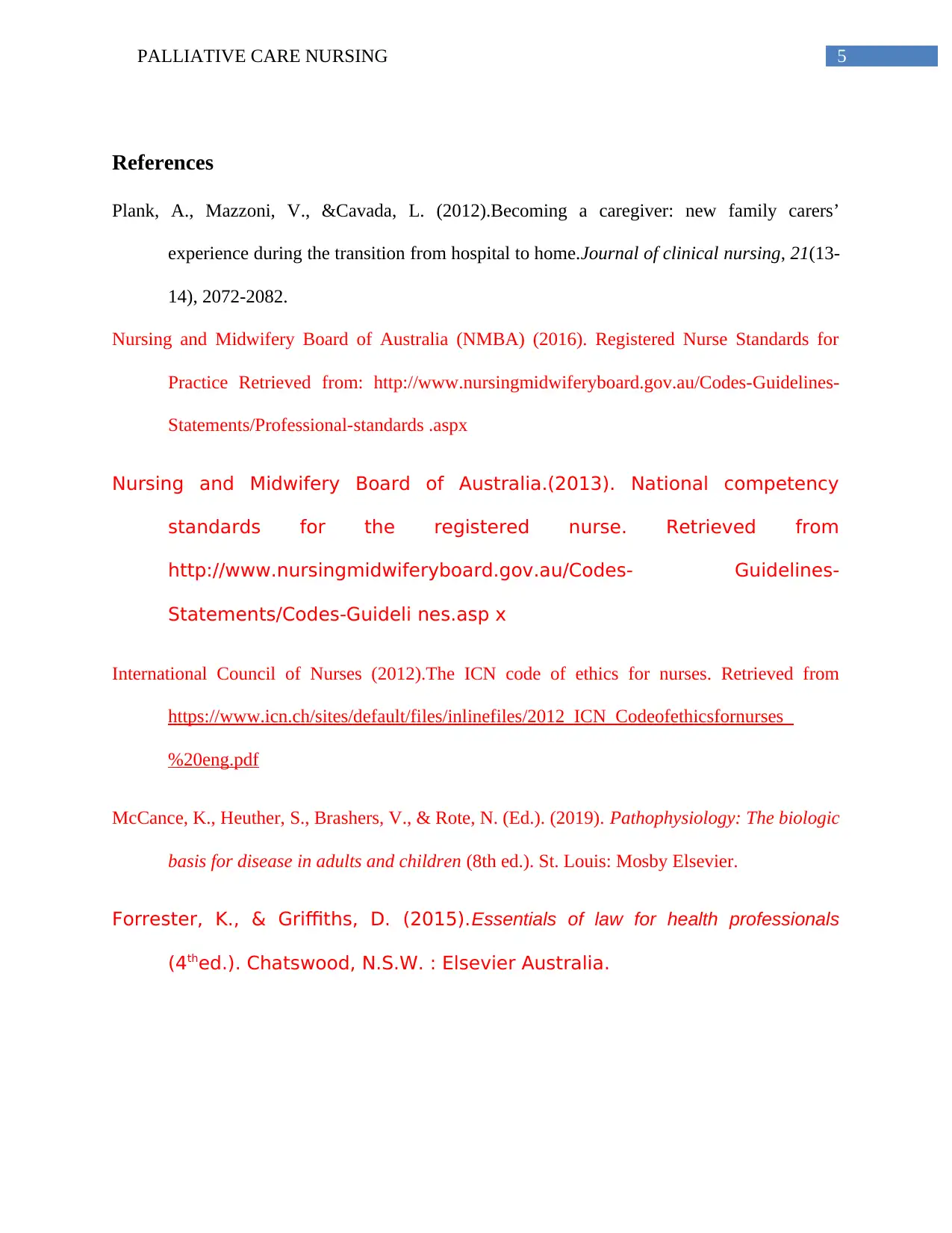
5PALLIATIVE CARE NURSING
References
Plank, A., Mazzoni, V., &Cavada, L. (2012).Becoming a caregiver: new family carers’
experience during the transition from hospital to home.Journal of clinical nursing, 21(13-
14), 2072-2082.
Nursing and Midwifery Board of Australia (NMBA) (2016). Registered Nurse Standards for
Practice Retrieved from: http://www.nursingmidwiferyboard.gov.au/Codes-Guidelines-
Statements/Professional-standards .aspx
Nursing and Midwifery Board of Australia.(2013). National competency
standards for the registered nurse. Retrieved from
http://www.nursingmidwiferyboard.gov.au/Codes- Guidelines-
Statements/Codes-Guideli nes.asp x
International Council of Nurses (2012).The ICN code of ethics for nurses. Retrieved from
https://www.icn.ch/sites/default/files/inlinefiles/2012_ICN_Codeofethicsfornurses_
%20eng.pdf
McCance, K., Heuther, S., Brashers, V., & Rote, N. (Ed.). (2019). Pathophysiology: The biologic
basis for disease in adults and children (8th ed.). St. Louis: Mosby Elsevier.
Forrester, K., & Griffiths, D. (2015).Essentials of law for health professionals
(4thed.). Chatswood, N.S.W. : Elsevier Australia.
References
Plank, A., Mazzoni, V., &Cavada, L. (2012).Becoming a caregiver: new family carers’
experience during the transition from hospital to home.Journal of clinical nursing, 21(13-
14), 2072-2082.
Nursing and Midwifery Board of Australia (NMBA) (2016). Registered Nurse Standards for
Practice Retrieved from: http://www.nursingmidwiferyboard.gov.au/Codes-Guidelines-
Statements/Professional-standards .aspx
Nursing and Midwifery Board of Australia.(2013). National competency
standards for the registered nurse. Retrieved from
http://www.nursingmidwiferyboard.gov.au/Codes- Guidelines-
Statements/Codes-Guideli nes.asp x
International Council of Nurses (2012).The ICN code of ethics for nurses. Retrieved from
https://www.icn.ch/sites/default/files/inlinefiles/2012_ICN_Codeofethicsfornurses_
%20eng.pdf
McCance, K., Heuther, S., Brashers, V., & Rote, N. (Ed.). (2019). Pathophysiology: The biologic
basis for disease in adults and children (8th ed.). St. Louis: Mosby Elsevier.
Forrester, K., & Griffiths, D. (2015).Essentials of law for health professionals
(4thed.). Chatswood, N.S.W. : Elsevier Australia.
⊘ This is a preview!⊘
Do you want full access?
Subscribe today to unlock all pages.

Trusted by 1+ million students worldwide
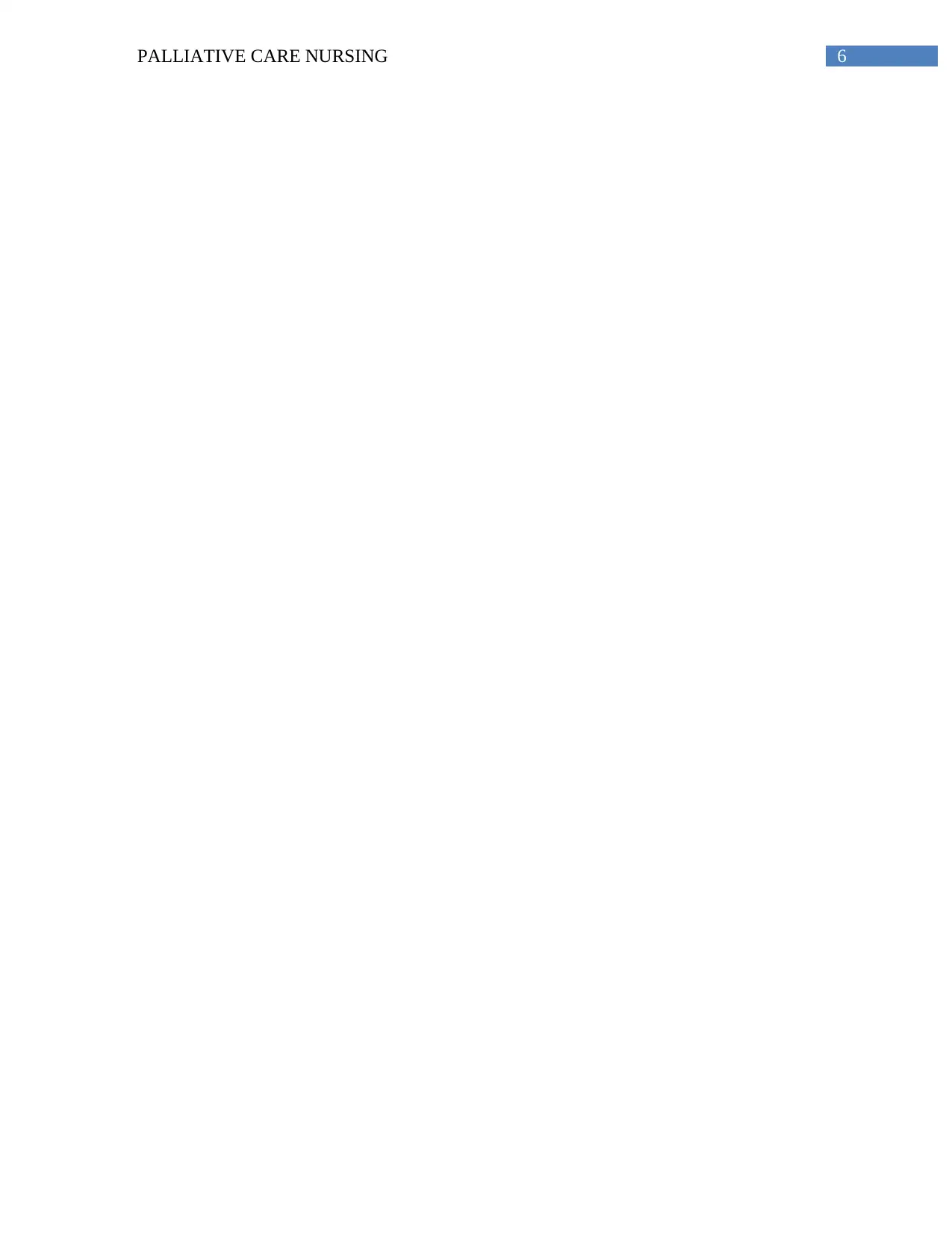
6PALLIATIVE CARE NURSING
1 out of 7
Related Documents
Your All-in-One AI-Powered Toolkit for Academic Success.
+13062052269
info@desklib.com
Available 24*7 on WhatsApp / Email
![[object Object]](/_next/static/media/star-bottom.7253800d.svg)
Unlock your academic potential
Copyright © 2020–2025 A2Z Services. All Rights Reserved. Developed and managed by ZUCOL.




